Even at the lower end of the business aircraft spectrum, speed is a valued asset. For people or companies looking to upgrade from piston power, a turbine single is a suitably pacy option. Piper's 260KTAS Meridian, at just over $2 million, represents the bottom of the single-engined price range, while the 270KTAS Pilatus PC-12, just north of $4 million, defines the upper end. In between is the $3 million Socata TBM 850, which has a maximum cruise speed of 320KTAS.
These three aircraft, all from established manufacturers, are not the only options available, however. The $2 million Epic LT, an experimental-category turbine single, promises a 325KTAS cruise speed and may be a viable option for those seeking a speed machine.
The Epic LT is nominally a "kit-built" aircraft assembled by its owner. Designed by Bend, Oregon-based Epic Air, the Epic LT first flew in 2004. Initially its manufacturer intended to market LT and also develop and sell a certificated model, the Dynasty. Financial difficulties and bankruptcy led to several ownership changes and abandonment of the Dynasty's development. Eagle-eyed observers may associate the Epic LT with ex-Cirrus Aircraft head Alan Klapmeier's Kestrel Aircraft Company (KAC) programme. Currently, there is no association between the Epic aircraft and the proposed KAC aircraft, now called the JP10.
The confusion arises as KAC used an Epic LT as the starting point for its prototype. The proposed offering from KAC will have little, if any, commonality with the current Epic LT.
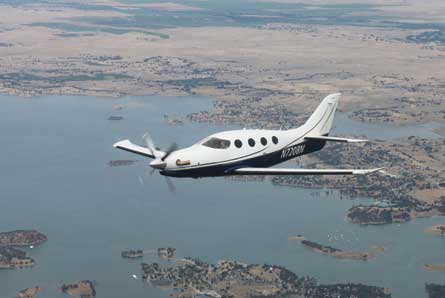 |
|---|
© Kevin MacRae |
Once an LT has received its special airworthiness certificate it can, for the most part, operate anywhere a certificated aircraft can |
Kit or amateur-built aircraft are issued a special airworthiness certificate in the experimental category under Part 21 of the US Federal Aviation Regulations. The Epic LT falls into this category and as an experimental aircraft, each completed one is issued an individual certificate.
The experimental designation prevents the Epic from being flown for hire but does not prevent it from being owned by a business and flown for business purposes. Once an LT has received its special airworthiness certificate it can, for the most part, operate anywhere a certificated aircraft can. Insurance for the Epic LT is readily available, according to Douglas King, chief executive of Epic Aircraft. On the downside, the Epic's experimental designation may limit financing options as well as making residual value calculations difficult. Federal Aviation Administration (FAA) requirements dictate that owners must perform 51% of the construction tasks for it to qualify as a kit/home-built aircraft. Epic LT owners actually build their carbonfibre aircraft in Epic's facility in Bend, Oregon.
The FAA requires 51% of the "tasks" be owner-accomplished, not 51% of the labour hours. With this in mind, Epic has structured the build process to ensure a high-quality compliant aircraft. During the six to 10-month build, owners are supervised by Epic technicians. Many of the intricate tasks needed to complete an LT are done by Epic staff.
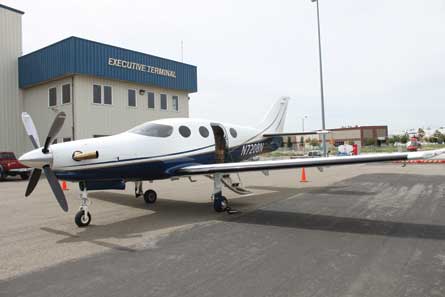 |
|---|
© Kevin MacRae |
Smaller than a King Air C90B but by no means diminutive compared with the C200 parked near it |
The majority of the carbonfibre structure, for instance, is built by Epic personnel. One critical step is the bonding of the two halves of the fuselage and vertical stabilizer structure. While it may appear to be as easy as joining the two halves of a plastic model aircraft, longitudinal symmetry is critical. After much testing, Epic has determined that curing the joined fuselage structure at a controlled temperature of 68˚F/20˚C is essential to building a "true" aircraft. Epic characterises the process as an owner-assisted build, with extensive supervision essential. Finally, some tasks not needed for basic airworthiness, such as installation of the pressurisation system and vapour-cycle air conditioner, are done after the aircraft has received its special airworthiness certificate. Flight International travelled to California's Central Valley to see first-hand just how capable a kit/home-built could be. The preview aircraft - serial number 202 and registration number N7208N - was completed in October 2007. Used by an agricultural concern and flown by a dedicated pilot, it had accumulated more than 1,000h.
The aircraft was on the ramp at Stockton Metropolitan Airport (KSCK) near a Hawker Beechcraft King Air. The Epic is slightly smaller than a King Air C90B, and was by no means diminutive compared with the larger C200 parked near it. Rich Finley, Epic's chief of engineering flight test, conducted the pre-flight safety inspection.
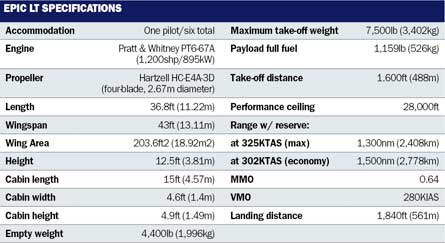 |
|---|
While the LT is a complex high-performance aircraft, in FAA terms, its pre-flight was no more involved than that of a Cessna 152. Checking the Pratt & Whitney PT6-67A's oil level required a ladder to reach the dipstick, as the engine cowling is quite high. Newer-build aircraft have an inspection door allowing a direct view of the oil-level sight glass.
As well as being more convenient, use of the sight glass is also safer. Improper resetting of the dipstick can allow oil to siphon out and has led to several engine failures on other aircraft types. The exterior finish on the preview aircraft was exceptional. All surfaces were smooth, with no visible ripples, befitting a composite aircraft.
Entry into the cabin was via integral steps in the manual door. "Experimental" is posted in large letters on the top of the doorjamb, alerting occupants that this is not your usual business aircraft. Eight pins hold the door in place and a pneumatic seal maintains the pressure-tight structure.
The spacious cabin is larger than a King Air C90B's, but 19.2"/48.9cm shorter and slightly narrower than the PC-12's. The six-place cabin, including two pilot seats, was arranged in a club four configuration. Baggage stowage is internal only; one area behind the pilot seats and the other behind the aft club seats. Eight large, tinted, oval windows allowed ample light into the well-appointed cabin.
The forward panel was configured with a two-screen Garmin G900X avionics suite. The G900X is a powerful system with Garmin's Safe Taxi and SVT synthetic vision systems. Approach charts can be displayed electronically, with the native Garmin FliteCharts or optional JeppView. The preview aircraft had a single AHRS and GPS receiver. King says the preview aircraft was the last two-screen Garmin built - all later aircraft have a three-screen G900X system, with dual AHRS and GPS receivers, or an Avidyne Entegra suite.
Conventional round-dial standby instruments were located in front of the right-hand seat. The control panel for the Tru Track Flight Systems Sorcerer autopilot was just below the glareshield of the forward instrument panel. An Electronics International MVP-50 glass-panel engine monitor and in-flight information system display were mounted just above the throttle quadrant. The MVP-50 has a weight-and-balance function, which may be a seldom-used feature for an LT owner. With full fuel tanks (288 US gallons/1,090l usable) the LT has a payload of 1,159lbs/526kg, enough for six occupants and some baggage.
Once seated in the left seat, the yoke and throttle quadrant levers came readily to hand. Side-stick controllers may be the future in FBW aircraft, but for conventional manual controls a well-placed old fashioned yoke such as the LT's is hard to beat.
FULL FORWARD
Starting the PT6 was a snap using only internal battery power. While I completed the post-start flows, Finley held the toe-actuated wheel brakes - the LT does not have a parking brake. Finley released the brakes and once we were rolling the condition lever was moved from "ground idle" to "flight idle" position (low and high idle, respectively). I found the manual nose-wheel steering fairly precise, allowing easy tracking of taxiway centrelines. The propeller control lever had been placed full forward and was left there for the whole flight, the propeller governed to 1,700rpm.
 |
|---|
© Kevin MacRae |
With full fuel tanks (288 US Gallons/1,090l usable) the LT has a payload of 1,159lbs/526kg, enough for six occupants and some baggage |
I used the Safe Taxi display on the multi-function display to guide me to the approach end of RWY29L. During taxi, use of reverse propeller pitch (beta) kept the LT at a reasonable speed. The electric actuated flaps were set to the TO position, as confirmed by looking out the side window. This LT, being an early build, lacked a flap position indicator.
While holding the wheel brakes on the runway and cleared for take-off, I advanced the power lever and set 80% NG (gas generator) RPM. After releasing the brakes I set 80% torque, torque being the power parameter used in most turboprops. Only a small amount of right rudder was needed to track centreline as the LT accelerated toward its rotation speed, 80KIAS. The yoke forces needed to attain a 10˚ pitch attitude were moderate, with a slight increase in right-rudder pressure needed to maintain coordinated flight once airborne. Gear and flap retraction caused little change in pitch forces as I established the LT in a 170KIAS climb.
During the climb to 7,500ft MSL, I saw climb rates approaching 4,000fpm. Once level we proceeded to a prearranged rendezvous point to join with the photographer's aircraft.
At 193KIAS a fuel flow of 60gph yielded a cruise speed 223KTAS. Prior to the join-up, the Garmin's TCAS display helped us get our eyes on the photographer's aircraft. During the climb and while manoeuvring for the photos, our speed ranged from 120 to 250KIAS. During numerous rolls I found the pitch and roll forces to be well harmonised and fairly light at lower speeds. I found the rudder to be very powerful with moderate forces. Rudder pedal travel was somewhat short, leading me to overcorrect in the yaw axis at times.
The rudder trim switch is mounted on the yoke's left grip, a four-way button switch that also controls pitch trim. The aileron trim switch is located on the yoke's right grip. I found this an odd arrangement as pitch and roll trim are usually coupled together with a standalone rudder trim switch.
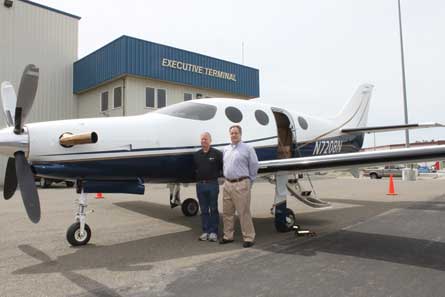 |
|---|
© Kevin McRae |
Michael Gerzanic (right), alongside Rich Finley, Epic's chief of engineering flight test |
The PC-12 has an auto rudder trim feature to counteract yaw due to power changes, and the Sorcerer autopilot in the LT can be equipped with a similar feature. The preview LT did not have this feature and good footwork and use of the handy rudder trim was needed to maintain co-ordinated flight.
After the photo portion of the flight was completed we had intended to climb to the LT's ceiling of 28,000ft and see how it performed at altitude. But a large area of thunderstorms was moving towards Stockton, and prudence dictated we return to KSCK for pattern work. For a fully loaded aircraft using a cruise climb profile, Epic lists a time to altitude of 13.5min. At its ceiling the LT has plenty of performance margin, but RVSM restrictions in the USA prevent it from routinely flying at or above FL290. At maximum cruise speed, 325KTAS, Epic lists an IFR range of 1,300nm/2,408km.
ROLLING OUT
Range increases to 1,500nm/2,778km if the LT is slowed to an economy cruise speed of 302KTAS. Data from customers indicate that fuel flow at maximum cruise speed is about 52gph and 45gph at economy.
The LT has a 6.5in delta P pressurisation system, which gives a cabin altitude of about 7,200ft at 28,000ft. During the low-altitude cruise portion of the flight, I found cockpit noise to be on the high side, and assume it would not be quieter at altitude.
Active noise-cancelling headsets made for an acceptable acoustic environment, while the voice-activated intercom eased intra-cockpit chatting.
Finley said newer-build LTs have much improved sound-proofing compared with our preview aircraft, showing Epic's commitment to continual refinement of its product.
Engine failure in any single-engined aircraft means a forced landing or ballistic parachute deployment. In the LT, Finley has the owner accomplish these three steps: Idle (idle power), Feather (propeller), Nearest (suitable field). With a feathered propeller the LT has a 17:1 glide ratio at 130KIAS.
Depending on altitude, a conventional overhead 360˚ flameout landing pattern may be performed. Overhead the field and in the landing direction, Epic recommends the LT be 2,500ft above ground level. On downwind abeam the landing point at 1,500ft AGL, gear and TO flaps are extended. On base or final, when landing is assured, the flaps are extended to full. In the Lockheed Martin F-16 I had done hundreds of simulated flameout landings, and Finley elected to simulate a more challenging scenario: loss of power shortly after TO. For safety reasons we performed the power-loss manoeuvre at 6,000ft mean sea level. The return to field manoeuvre is all about energy management.
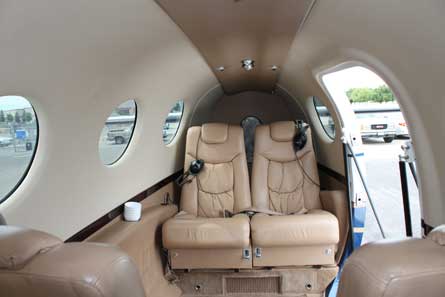 |
|---|
© Kevin Macrae |
The Spacious cabin is larger than a King Air C90B's |
Finley recommends using a minimum airspeed of 160KIAS, not an altitude, as the decision point for a return to field landing. While climbing at 160KIAS in clean configuration Finley rapidly set a zero-thrust power setting, to simulate a feathered propeller.
Our closest field was the departure field, where we would do a downwind landing. I rapidly pulled the nose up, exchanging kinetic energy for potential energy, in pilot terms trading airspeed for altitude. Once in a 25˚ climb as we slowed through about 115KIAS I sharply banked the aircraft to the left, doing a whifferdill or wingover, towards the field.
Halfway through the 180˚ turn while slowing through 90KIAS I felt a slight burble on the tail and extended the flaps to the TO position. While rolling out aligned with the simulated runway, the gear was extended and flaps set to full. For LT pilots, a power-loss event is unlikely but still possible. Emergency training and practice is essential for safe operation.
Emergency training complete, we returned to KSCK where I was able to perform two full-stop landings. In the pattern the LT can fly fast enough to mix with business jets and slow enough to mingle with trainer aircraft.
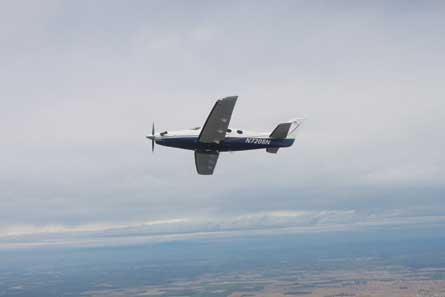 |
|---|
© Kevin MacRea |
For a fully loaded aircraft using a cruise climb profile, Epic lists a time to altitude of 13.5min |
For each landing, a power-on-full-flap approach was flown, with a target speed of 95KIAS. Once settled on the runway, reverse-propeller thrust/beta was used to slow the aircraft for runway turnoff.
Taxi to the ramp and engine shutdown after the one-hour flight were uneventful. My brief flight reminded me there is plenty of room in aviation for unique and capable aircraft. You would be hard-pressed to find a single-engined turboprop as fast as the Epic LT, nor one that carried as much as far. Used certificated business jets are available at the LT's price point, but they have higher operating costs and lack its range and payload capabilities.
The level of fit and finish on the preview aircraft was exceptional, but the cabin acoustic environment shows there is room for refinement. With a high level of standard equipment and avionics the Epic LT may be just the right answer for those willing to help polish their own diamond.
Here's a video of Mike's initial impressions with the aircraft immediately after the flight test.
For the low-down on how civil and military aircraft fare in the air, visit our archive of flight-test reports at flightglobal.com/flighttests
Source: Flight International
















